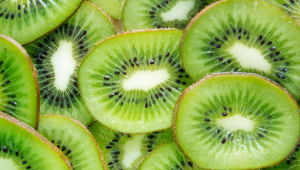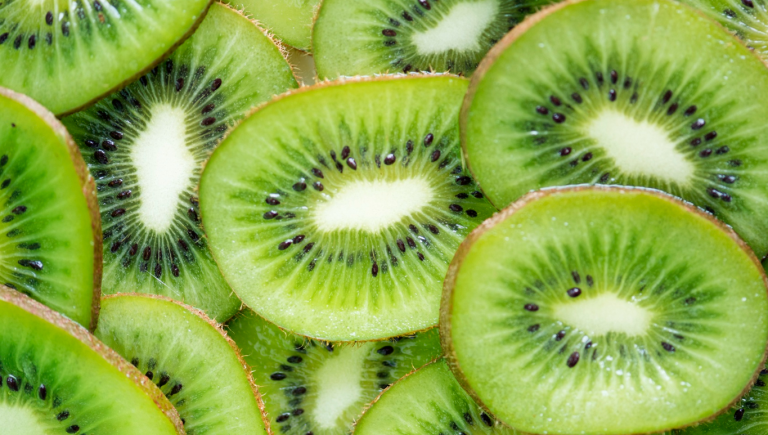Eating kiwis with their skins on has been subtly evolving from a strange fad to a legitimate health tactic in recent years. Kiwi skin, which was once written off as a fuzzy, slightly strange outer layer that should be thrown away, is now gaining acceptance in health-conscious practices, and not just among dietitians. More people are realizing its benefits, from smoothie-loving celebrities to functional wellness specialists.
The skin of both green and golden kiwis contains a number of health-promoting compounds that are surprisingly nutrient-dense and frequently misunderstood. Reputable sites like Healthline and the Cleveland Clinic claim that eating kiwi skin can boost fiber intake by as much as 50%. That’s a big boost from a single little adjustment. Furthermore, vitamin E, folate, and polyphenols—all substances linked to immune support, skin health, and digestive comfort—are abundant in the skin.
Kiwi Skin: Nutritional Snapshot for WordPress Embeds
| Attribute | Details |
|---|---|
| Edibility | Yes—green and golden kiwis can both be eaten whole |
| Nutritional Gains (with skin) | +50% fiber, +34% folate, +32% vitamin E |
| Texture Differences | Green: fuzzy and fibrous; SunGold: smooth and hairless |
| Fiber Composition | Soluble (pectin) + Insoluble (cellulose, hemicellulose) |
| Antioxidants | 30% of polyphenolics in SunGold come from skin |
| How to Eat | Wash and eat whole, slice like apples, or blend with skin |
| Digestive Enzyme Present | Actinidin—supports protein digestion, more abundant in green kiwi |
| Allergy Note | Mild allergic reactions possible; consult doctor if sensitive |
| Popular with Influencers | Endorsed in smoothies and diets by health-minded celebrities |
| Official Reference | Zespri Blog – Kiwi Skin Edibility |
Let’s compare kiwi skin to peach peel for those who are still undecided. Both have fiber and antioxidants, are slightly fuzzy, and can be eaten whole after a mild wash. Perception is the only distinction. But that is rapidly changing.

Eating kiwi skin aligns with a broader trend toward whole-ingredient diets in terms of clean eating and minimizing food waste. Both chefs and nutritionists advise eating whole fruits, skin and all, not only for the sake of the environment but also because throwing away the peel frequently results in losing a sizable portion of the fruit’s nutrients. Consider it as a part of the experience, and in this case, the health benefit, of throwing out the crust on artisan sourdough.
The Zespri SunGold variety has become more well-known in recent years, particularly among wellness influencers. SunGold avoids the typical texture issues associated with green kiwis thanks to its smooth, hairless exterior and tropically sweet interior. Furthermore, this type’s skin is not only more palatable to the taste buds but also provides 32% more vitamin E and 34% more folate per serving.
This micronutrient profile is especially helpful for pregnant women and fitness professionals. Folate, which is essential for cellular repair and fetal development, is frequently recommended through supplements. Obtaining it straight from a fresh fruit, skin and all, provides a natural substitute. In a similar vein, vitamin C in the flesh and vitamin E in the skin form a potent antioxidant pair that is known to promote skin regeneration and immune function.
It’s clear from discussions on Reddit threads and food forums that people’s perceptions of kiwi skin are progressively changing. Users passionately debate whether the fuzzy layer improves or detracts from the eating experience in threads such as r/AskCulinary. It’s interesting to note that proponents of eating skin-on frequently praise its earthy flavor and gratifying mouthfeel, referring to it as a “textural contrast” that becomes more pronounced with time.
By incorporating kiwi skin into your diet, you’re supporting larger sustainability and health movements in addition to improving your snack game. This change is also reflected in current beauty trends. Packed with enzymes and polyphenols, kiwi skin extracts are starting to show up in skincare products that promise a more natural glow and better texture. Once limited to fruit bowls, these antioxidants are now found in hydrating masks and night creams.
My own testing revealed that the switch was simple when combined with sliced strawberries or added to a bowl of Greek yogurt. Even though it was initially a little annoying, the green kiwi’s fuzz soon became inconspicuous, especially after I recalled the extra fiber it provided. This daily shortcut felt like a win for someone who frequently forgets to take multivitamins.
However, people with known sensitivities are cautioned. Green kiwis are significantly higher in the enzyme actinidin, which is responsible for their reputation as meat tenderizers. SunGold might be a more gentle introduction if you’ve previously had oral irritation from kiwis. The safest course of action is to consult a doctor if in doubt.
From a trend standpoint, the popularity of “skin-on” kiwi eating reflects comparable changes in our perceptions of food presentation and texture. Fruits that were once peeled and pared for aesthetic reasons are now being praised in their unadulterated, raw state. This includes whole kiwis, unpeeled cucumbers, and seeded grapes. According to this movement, accepting nature for what it is is more important for health than striving for perfection.


